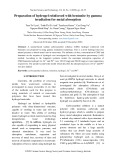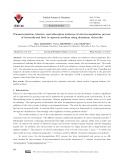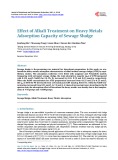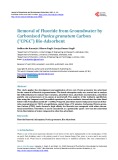
Langmuir adsorption isotherm model
-
According to the batch experiments, the adsorption isotherms and the adsorption kinetics for these mesoporous materials are well fitted with the nonlinear Langmuir model and the nonlinear pseudo-second-order model, respectively. Among them, CuFe2O4 powder showed the best phosphate adsorption performance with the maximum P adsorption capacity of 27.49 mgP g-1 , which can be assigned to the highest surface area and the high pH value at its point of zero charge.
 7p
7p  dianmotminh02
dianmotminh02
 03-05-2024
03-05-2024
 6
6
 1
1
 Download
Download
-
Contaminants in plating wastewater are hard to remove, especially hexavalent chromium ions. This waste stream contains a large amount of Cr6+, a highly toxic metal, potential to cause cancer. To reduce this pollution, sludge from a supply water treatment plant (DWTS) has been used to make adsorbent.
 13p
13p  viannee
viannee
 02-08-2023
02-08-2023
 3
3
 3
3
 Download
Download
-
In study "Using quail eggshell to treat methylene blue in aqueous solution", the raw quail eggshell powder (RQEP) was utilized as a cheap and environmentally friendly adsorbent to remove methylene blue (MB) from aqueous media under different conditions. The morphology of the prepared adsorbent was determined by scanning electron microscopy. The Langmuir and Freundlich isotherm models were used to model the adsorption data. The obtained results showed that the adsorption of MB on RQEP was well-fitted with the Freundlich model.
 8p
8p  nhanchienthien
nhanchienthien
 25-07-2023
25-07-2023
 4
4
 3
3
 Download
Download
-
In this study, the sugarcane bagasse grafted with citric acid was used as a low-cost biosorbent for removal of dyes from the textile wastewater. The adsorption parameters such as initial pH values, dyes concentrations, adsorbent dosages and contact times were investigated by the batch experiments. The Freundlich and Langmuir adsorption isotherm models were used to evaluate the experimental data.
 6p
6p  vidoctorstrange
vidoctorstrange
 06-05-2023
06-05-2023
 6
6
 2
2
 Download
Download
-
Kaolin sample (mixture of halloysite and kaolinite) from Thach Khoan, Phu Tho province was studied to remove Pb2+ ions from an aqueous solution. The SEM-EDS and TEM analysis showed that in the kaolin sample, tubular halloysite and plate kaolinite minerals coexist, similar to the results from previous studies.
 9p
9p  vimelindagates
vimelindagates
 18-07-2022
18-07-2022
 4
4
 2
2
 Download
Download
-
The mechanism of dye-adsorbent interaction is described on the basis of zero-point charge and zeta potential techniques. Batch adsorption studies on MCH NM show excellent adsorption activity of 199.02 mg/g in 22 min towards RB13 dye, maximum value ever reported for any reactive dye. Equilibrium adsorption data and adsorption kinetics were well fitted into Langmuir isotherm model and pseudo second order model predicting chemically rate controlled monolayer adsorption.
 9p
9p  thebadguys
thebadguys
 15-01-2022
15-01-2022
 12
12
 1
1
 Download
Download
-
The particle load removal isotherm model followed the Langmuir model. Therefore, it can be inferred from the study that MSC can be used effectively in coag-flocculation for removal of particle load from paint effluent (PE).
 13p
13p  thebadguys
thebadguys
 15-01-2022
15-01-2022
 7
7
 0
0
 Download
Download
-
CO2 adsorption capacities of activated carbon-based adsorbents subjected to different treatments, such as HNO3 oxidation, air oxidation, alkali impregnation, and heat treatment under helium gas atmosphere, were determined by gravimetric analyses and reported previously by our group. In the current work, the experimental adsorption isotherms of these modified activated carbon samples were fitted to Langmuir, Freundlich, and Dubinin–Radushkevich (D-R) models.
 12p
12p  langthannam
langthannam
 29-12-2021
29-12-2021
 7
7
 0
0
 Download
Download
-
Magnetic amidoximated nanocomposites based on a combination of chitosan and magnetic laponite RD were prepared and examined for the removal of Cu2+ from aqueous solutions. Magnetic laponite RD was prepared by an in situ method. In order to prepare magnetic amidoximated nanocomposites, acrylonitrile was grafted to chitosan in the presence of magnetic laponite RD. Then the nitrile pendants on magnetic chitosan-g-polyacrylonitrile/laponite RD (mChtioPANLap) were converted to amidoxime groups.
 18p
18p  langthannam
langthannam
 29-12-2021
29-12-2021
 11
11
 0
0
 Download
Download
-
A series of batch lab-scale experiments were performed to investigate the performance of dead phosphorylated algal biomass of Spirogyra species for the bioadsorption of Cu +2 ions from aqueous solutions. FT-IR and SEM analyses were performed to characterize the phosphorylated and raw algae. The SEM analysis indicated that the phosphorus content increases by about 5 times. The isotherm equilibrium data indicated that phosphorylation enhances the removal of Cu +2 from water by about 20%. The experimental isotherms fit well to Langmuir models with R 2 values close to 0.99.
 19p
19p  langthannam
langthannam
 29-12-2021
29-12-2021
 9
9
 0
0
 Download
Download
-
A novel adsorbent Fe3O4/Ni/NixB nanocomposite was synthesized and used for the adsorption of copper. Moreover, natural adsorbents carob and grape seeds were used for this purpose. The surfaces and the elemental compositions of the adsorbents were characterized by SEM-EDX. The zero point charges of pH of Fe3O4/Ni/NixB nanocomposite, carob, and grape seeds were found as 8.4, 6.0, and 5.6, respectively. The Langmuir, Freundlich, and Dubinin–Radushkevich isotherm models were used for the identification of the mechanism of the adsorption.
 13p
13p  tudichquannguyet
tudichquannguyet
 29-11-2021
29-11-2021
 13
13
 1
1
 Download
Download
-
Adsorption processes of Cd(II) and Pb(II) from aqueous solutions onto pumice stone powder (PSP) were investigated in batch mode. The influences of solution pH, contact time, adsorbent dosage, initial metal (M) concentration, and temperature on adsorption process were investigated. The kinetic and isotherm data were analysed using different model equations. The adsorption process was consistent with the Langmuir model for both metal ions with high R2 and low χ2 values for both Pb(II) and Cd(II). The maximum monolayer adsorption capacities were 28.09 and 27.
 12p
12p  tudichquannguyet
tudichquannguyet
 29-11-2021
29-11-2021
 14
14
 0
0
 Download
Download
-
Resins coated with nickel/nickel boride nanoparticles were used to remove brilliant green, methyl violet, methylene blue, phenosafranine, and brilliant cresyl blue from water. The effects of pH, adsorbent dose, contact time, and initial dye concentration on the adsorption efficiencies were investigated. The point of zero charge for the adsorbent was pH 9.5. Isotherm studies were conducted using Langmuir, Freundlich, and Dubinin–Radushkevich models, and thermodynamic studies were also performed. Adsorption of the five dyes was found to obey the Langmuir isotherm model and was endothermic.
 15p
15p  tudichquannguyet
tudichquannguyet
 29-11-2021
29-11-2021
 25
25
 1
1
 Download
Download
-
In the present study, calcined layered double hydroxides (CLDHs) were obtained by heating [Zn2-Al-CO3 ] at 500◦C. The adsorption of the textile dye acid green 1 (AG1) by CLDH was carried out at different pH levels, adsorbent–adsorbate contact times, and AG1/CLDH mass ratios. Equilibrium at room temperature was reached after 24 h, which was confirmed by the kinetic modeling of the experimental data by the pseudo-second-order model. The adsorption is described by a Langmuir-type isotherm.
 15p
15p  tudichquannguyet
tudichquannguyet
 29-11-2021
29-11-2021
 9
9
 1
1
 Download
Download
-
The influence of dose, concentration of CMC and bentonite on the sorption of hydrogels was investigated by atomic absorption spectrometry (AAS) method. According to the Langmuir isotherm model, the maximum adsorption capacities of CMC/bentonite hydrogel for Cu2+ and Pb2+ were 181.82 mg/g and 204.08 mg/g at room temperature, respectively. The pseudo-second-order model which describes the adsorption process of Cu2+ and Pb2+ was also studied. Mời các bạn tham khảo!
 8p
8p  princessmononoke
princessmononoke
 29-11-2021
29-11-2021
 14
14
 1
1
 Download
Download
-
The removal of bromothymol blue (BTB) from aqueous solution was studied by electrocoagulation (EC) technique using aluminum electrodes. The various experimental conditions known to influence the EC process were parameterized, including the effects of temperature, concentration, current density, pH, and treatment time. The results obtained have shown that optimum removal efficiency of 99.9% was realized at a current density of 20 mA/cm2 and pH of 4.7. The adsorption process showed a pseudo-first-order kinetic model as the best fit to the EC data.
 21p
21p  tudichquannguyet
tudichquannguyet
 29-11-2021
29-11-2021
 15
15
 1
1
 Download
Download
-
This study aimed to evaluate the ability of magnesium chloride modified carbonized rice hull (MCRH) material for ammonium removal from synthetic and domestic wastewater. The MCRH material was prepared by using waste rice hull from a household rice-processing factory and magnesium chloride salt via a simple mixing and annealing method. The material was then characterized by scanning electron microscopy and energy-dispersive X-ray spectroscopy.
 11p
11p  angicungduoc5
angicungduoc5
 13-06-2020
13-06-2020
 10
10
 1
1
 Download
Download
-
Sewage sludge is the promising raw material for biosorbent preparation. In this work, we evaluated the heavy metals adsorption characteristics of alkali treated sewage sludge (ATSS) by equilibrium studies. The adsorption isotherms were fitted with Langmuir and Freundlich models. Comparing with untreated sewage sludge, the total adsorption capacity (qm) of ATSS (prepared with 0.125 mol/L NaOH) for Cd, Pb, Ni, increase d by 0.51, 0.70 and 0.32 mmol/g, respectively. When the NaOH concentration for ATSS preparation increase d from 0.125 mol/L to 0.
 7p
7p  mentospurefresh
mentospurefresh
 29-11-2019
29-11-2019
 17
17
 1
1
 Download
Download
-
This study applies the development and application of low cost, Punica granatum bio- adsorbent for the removal of fluoride in groundwater. The batch adsorption study was carried out to analyze the defluoridation by contact time variation, adsorbent dose, adsorbate concentration, adsorbent particle size and presence of coanions at neutral pH. The analysis of the isotherm equilibrium data using the Langmuir and Freundlich equations by linear methods showed that the data fitted better with Freundlich model (R 2 0.980).
 9p
9p  mentospurefresh
mentospurefresh
 29-11-2019
29-11-2019
 18
18
 1
1
 Download
Download
-
Adsorption is one of the primary processes for removing arsenic from drinking water. This study focuses on developing inexpensive and effective adsorbents to remove arsenic from ground water. Eight different types of adsorbents were prepared. Some of these materials were chemically modified. The efficiency of percentage adsorption of arsenite, As(+III) on different materials were investigated at different pH, contact time and initial concentrations. Out of eight different types of adsorbents, the iron-loaded xanthated orange waste (Fe-XOW) showed high efficiency for the removal of arsenic.
 10p
10p  nguathienthan1
nguathienthan1
 27-11-2019
27-11-2019
 38
38
 2
2
 Download
Download
CHỦ ĐỀ BẠN MUỐN TÌM









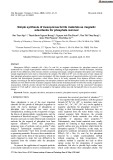
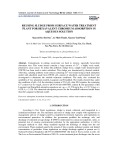
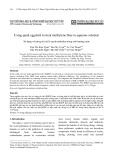
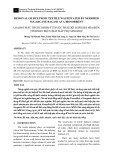
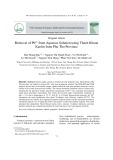

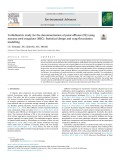
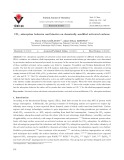
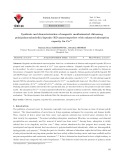

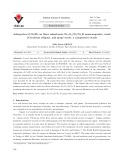

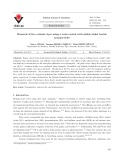
![Use of calcined layered double hydroxide [Zn2-Al-CO3] for removal of textile dye acid green 1 from wastewater: Kinetic, equilibrium, comparative, and recycling studies Use of calcined layered double hydroxide [Zn2-Al-CO3] for removal of textile dye acid green 1 from wastewater: Kinetic, equilibrium, comparative, and recycling studies](https://tailieu.vn/image/document/thumbnail/2021/20211129/tudichquannguyet/135x160/3351638156012.jpg)
